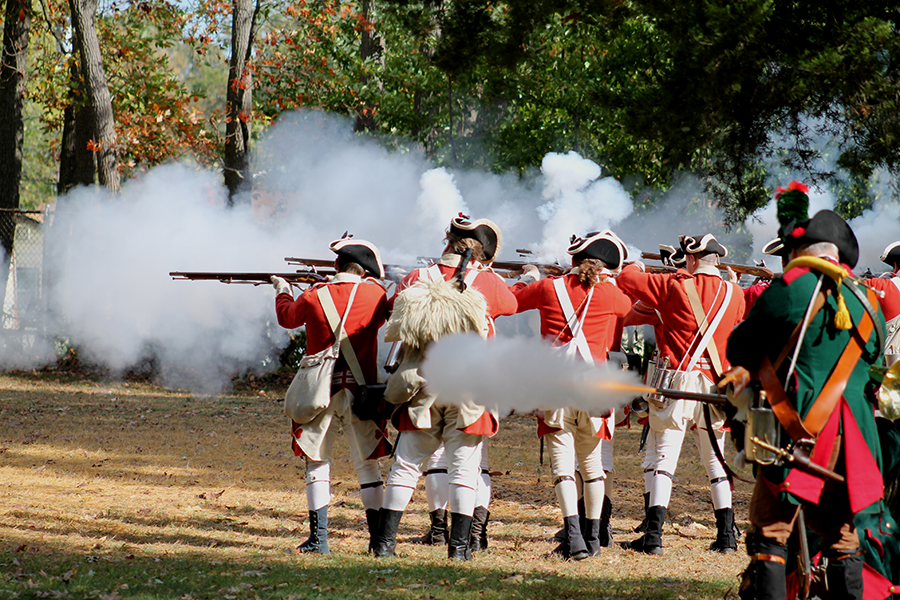Red Bank Battlefield

Neslted along the Delaware River in National Park, Red Bank Battlefield Park offers an oasis for recreation and relaxation with an unobstructed view of the Philadelphia waterfront.
It’s a marked contrast to the event that gave the 44-acre park its name. On Oct. 21, 1777, an outnumbered band of American troops at Fort Mercer defeated Hessian forces in the Battle of Red Bank.
That key event in the American Revolution will be remembered with an 18th century Field Day on Oct. 21. Visitors will get a chance to see battle re-enactors and experience what life was like back then with demonstrations of blacksmithing and yarn spinning and a Colonial-era magic show.
The park’s centerpiece is the James and Ann Whitall House, the Colonial-era home that served as a makeshift hospital for the battle’s casualties. Guided tours of the home will be given.
“When it was built in 1748, it was the largest home on the Delaware River in Gloucester and Salem counties,” says Karen Heller of Wenonah, a docent at the park.
“The house's brick construction and size showed wealth and status,” notes Jennifer Janofsky, curator of the Whitall House. The 10-room mansion and basement were a good fit for the Whitalls who had diversified business interests that included fruit orchards, a lumberyard, a shad fishery, livestock, and a ferry service on their 400-acre plantation.
The home played a role in giving the site its name, according to Bob Barnshaw of Deptford, another park docent. “The Whitall Farm was perched on a bank of earth that appeared to be red from the river,” he says.
With the start of the American Revolution, the Whitalls’ plantation and its location along the Delaware and across from Philadelphia, which served as the U.S. capital, took on greater importance.
It was a prime site for a fort to defend the river against the British, Barnshaw notes. “It was one of the highest points on the east side of the Delaware River.”
“The army had long been interested in the Whitall property. Given its prime location directly across from Fort Mifflin (in Philadelphia), it was a no-brainer they wanted that land,” Janofsky adds.
The Whitalls were Quakers, members of the Society of Friends, and were neutral. “(The Army) did offer to purchase it, but the Whitalls declined. Then they took it by force/eminent domain,” she points out.
Fort Mercer, named for Brigadier General Hugh Mercer who was mortally wounded in the Battle of Princeton in January 1777, was constructed quickly later that year.
“(George) Washington briefly visited Fort Mercer to inspect the fort’s defenses,” Barnshaw says of the earthen-and-log installation, about a quarter mile from the Whitall home.
After Philadelphia fell to the British in September 1777, the British needed control of the Delaware to bring supplies into the city. However, the Americans had deployed a series of underwater obstructions called chevaux de fries – sharpened wooden spikes – to keep British ships from Philadelphia.
That set the stage for the battle as the Hessians gathered in Haddonfield and prepared to march to Fort Mercer. Jonas Cattell, an American soldier, heard of the plans and ran 10 miles to the fort to warn U.S. forces of the impending battle. His athletic feat is commemorated with the Jonas Cattell Memorial Run, a 10-mile race from Haddonfield to National Park the morning of Oct. 21.
“Due to his local origins and the famous ‘annual’ run, he has become to the Battle of Red Bank what Paul Revere has become to the Lexington/Concord engagements, that is a legend probably out of proportion to the facts,” says Barnshaw. He notes that Colonel Christopher Greene, the U.S. commander at the fort, already knew the Hessians were in Haddonfield and likely to attack. “But (Cattell’s) service was brave and he certainly deserves much credit for it.”
Greene’s troops of about 500 men soundly defeated the Hessian force, estimated at 1,200 to 1,500 men and led by Gen. Carl von Donop. He had demanded the Americans surrender the fort, but was rejected. His troops were ill-prepared and did not have ladders to scale the fort’s walls. Barnshaw notes that the general could have laid siege to the fort, but opted to go on the offensive and his men were rebuffed in three separate attacks. The battle was relatively brief but bloody with the Hessians suffering the brunt of the casualties in fighting that lasted just over an hour. “The Hessians are believed to have lost 350 to 400 killed, wounded and missing,” says Barnshaw, adding that the figures are estimates. Von Donop, who was wounded, died of his injuries on Oct. 25.
In contrast, Barnshaw said American casualties were estimated at 14 killed, 21 wounded and one missing.
At home, Ann Whitall continued her daily routine. “Legend has it that Ann Whitall sat at her spinning wheel while the battle raged around her,” Heller says. “When a stray cannonball hit the wall, she went to the basement.” After the battle, the 10-room mansion was transformed into a hospital. “We know from contemporary accounts the house was packed with the wounded,” Janofsky says, with some staying there for two weeks.
The Whitalls tried to receive compensation for the damage done to their property, which included the cutting down of several hundred apple trees to build the fort.
“In April 1779, James Whitall filed a claim with the New Jersey Legislature for 5,760 pounds and 1 shilling for damages done to his property and home,” Heller notes. “There’s no record that the claim was ever paid.”
Fort Mercer had a short life. After the British captured Fort Mifflin in November, U.S. forces abandoned Fort Mercer and it was demolished by year’s end. Remnants of the ditch built around the fort still can be seen and several cannons have been unearthed at the site over the years. An archaeological dig in 2015 unearthed several historical items, including a picture frame and religious relic.
“The most significant find was an 848-pound cannon fragment,” Janofsky says.
Gloucester County acquired the park in 1905 and it became a National Historic Landmark in 1972. The park offers year-round activities to attract visitors, including a Halloween-theme fall festival on Oct. 27 and a holiday candlelight tour of the Whitall House from Dec. 7-9.
“For years, we’ve been trying to promote it,” says county Freeholder Frank J. DiMarco, liaison to the Department of Parks and Land Preservation.
A self-guided walking tour of the park is in the works and will be available to visitors by year’s end.
“Visitation to the park for 2017 was 144,068,” Janoksky says. “We also track visitation to the Whitall House and it was roughly 5,000.”
Janofsky is upbeat about the park’s future. “One of my goals when starting my position was to bring more attention to the Battle of Red Bank,” she says. “A lot of communities have historic house museums similar to the Whitall House. But most communities don't have a significant battlefield.
“I think we've also come a long way in making our site family friendly, accessible and exciting to everyone through great programming and offering a more inclusive story of colonial America, whether it be the heroic efforts of African American troops or the role indentured servants played in managing the farm. We've worked hard to move away from ‘top down history’ to history from ‘the bottom up.’”
(Red Bank Battlefield Park is at 100 Hessian Ave., National Park. The park is open daily from sunrise to sunset except for Christmas and New Year’s Day. The James and Ann Whitall House is open seasonally from mid-April to mid-October, most Thursdays through Sundays, from 1 p.m. to 4 p.m. Tours by appointment are available at other times when a docent is available. Call (856) 853-5120. For more information, visit http://www.gloucestercountynj.gov/depts/p/parks/parkgolf/redbank/)






